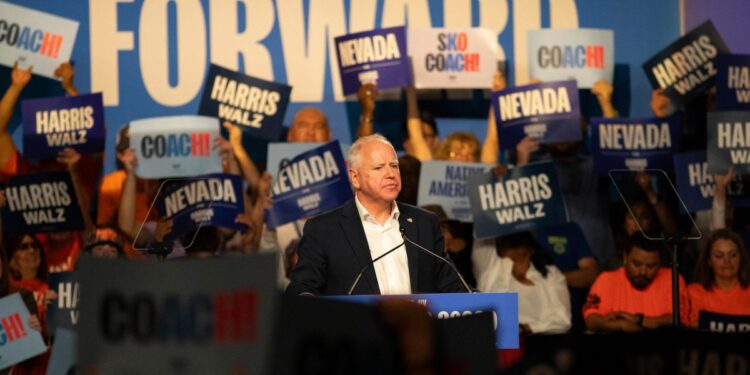At a pair of fundraisers on Tuesday, Gov. Tim Walz called for abolishing the Electoral College. “I think all of us know, the Electoral College needs to go,” he told Democratic donors at the home of California Gov. Gavin Newsom. “We need a national popular vote.”
The Harris campaign said that it did not support Walz’s position and the New York Times wrote that his statement risked “rocking the boat for the Harris campaign as it tries to deliver a message focused on economic concerns, abortion rights and the threat of former President Donald J. Trump.” Trump’s campaign posted on X, “Why does Tampon Tim hate the Constitution so much?”
But the Democratic vice presidential nominee is right—the Electoral College should be abolished. Sixty-three percent of Americans agree with that position, according to a recent Pew Research Center poll.
Here are 5 reasons why the Electoral College “needs to go”:
It’s fundamentally undemocratic
Every sports fan knows that the team that scores the most points wins the game. But that’s not how America elects its president. The US is the only major democracy where you can lose the popular vote but win the Electoral College (or that even has an Electoral College). Not only is the Electoral College out of step with the rest of the world, no other major elected office in America, at the federal or state level, uses a similar system. It violates the most basic notions of “one person, one vote.”
It excludes the vast majority of Americans from counting
The seven swing states that will decide the 2024 presidential election represent 15 percent of the country’s population. That leaves 85 percent of Americans with little incentive to vote for the nation’s highest office, whether you’re a Republican in California or a Democrat in Tennessee. That impacts down-ballot races as well and depresses voter turnout across the country.
It’s unrepresentative of the country
As I reported in April:
The tiny handful of battleground states are whiter and more Republican than the rest of the country. Eighty-three percent of voters in Wisconsin, Michigan, and Pennsylvania in the 2020 election were white, according to the New York Times, compared with 69 percent of voters elsewhere. Wisconsin, the tipping-point state in 2020, is also 3.5 points redder than the country as a whole. University of Texas political scientists estimated in 2019 that in a 50–50 popular vote election, the Republican candidate had a 65 percent chance of winning the Electoral College.
It incentivizes election rigging
Joe Biden won the popular vote by 7 million votes in 2020 but carried the three closest states in the Electoral College by just 44,000 votes. Trump never could have attempted to overturn the results—and there would have been no insurrection—if the United States had a system in which every vote mattered equally in presidential elections.
The system remains dangerously vulnerable to partisan manipulation. Just recently, the Trump campaign tried to change the way Nebraska allocated its electoral votes, which could have led to a tie in the Electoral College, throwing the election to the House and leading to a full-blown constitutional crisis. The plan failed when one Democrat-turned-Republican state senator opposed the move. It’s never a good thing when the fate of American democracy comes down to one state rep from Omaha.
It’s racist and antiquated
Most of the founding fathers, who wanted to protect the power of an elite, white male, propertied minority, opposed the direct election of the president. Both the small states and the slave states argued that a popularly elected president would threaten their influence. As I write in my book Minority Rule, Virginia’s James Madison, the most influential drafter of the Constitution, said at the Constitutional convention that “the people at large was in his opinion the fittest” way to choose the president, according to a record of the debates. But, he added, “there was one difficulty however of a serious nature attending an immediate choice by the people. The right of suffrage was much more diffusive in the Northern than the Southern States; and the latter could have no influence in the election on the score of the Negroes.”
The South would be at a major disadvantage in a popular election, Madison was admitting, because its enslaved population could not vote. Pennsylvania’s James Wilson, who had initially proposed a popular election of the president, then recommended a complicated alternative where electors—either chosen by the states or the voters—would select the president. The number of electors a state received would be based on their representation in both houses of the legislature, which gave a huge boost to the small states because of equal representation in the Senate and to the slave states because of the three-fifths clause in the House. Even though electors now generally follow the will of their state’s voters, the Electoral College remains biased toward the same groups it favored at its inception.
There are two ways to get rid of the Electoral College. A Constitutional amendment requires the support of two-thirds of Congress and three-quarters of states, a very heavy lift in today’s polarized political climate. A constitutional amendment to abolish the Electoral College almost passed in 1970 with huge bipartisan support, but it was filibustered by racist Southern senators who believed that previously disenfranchised Black voters would have more power in a direct popular election.
Then there’s the National Popular Vote Interstate Compact, an agreement among states to award their electoral votes to the winner of the popular vote. It needs 270 electoral votes to go into effect and currently has the support of states with 209 electoral votes. Last year, Walz signed legislation adding Minnesota to the compact.
He was right then, and he’s right now. Democrats can’t credibly run on protecting American democracy if they continue to support the most undemocratic part of America’s political system.







